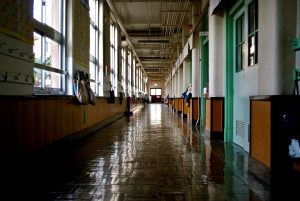
September 13, 2021, by Rupert Knight
Primary-Secondary transition
As schools return and a new cohort of Year 7s begin, John Perry reflects on the move from primary to secondary education and how primary teachers can support this process over the coming year.
A minute ago it was June. Now the weather is September. The crops are high, about to be cut, bright, golden.
November? unimaginable. Just a month away.
The days are still warm, the air in the shadows sharper. The nights are sooner, chillier, the light a little less each time.
Dark at half past seven. Dark at quarter past seven, dark at seven.
The greens of the trees have been duller since August, since July really.
But the flowers are still coming. The hedgerows are still humming. The shed is already full of apples and the tree’s still covered in them.
The birds are on the powerlines.
The swifts left weeks ago. They’re hundreds of miles from here by now, somewhere over the ocean.
(Smith, 2016, p.85)
Autumn
Autumn is a time of transition as the quote above, from Ali Smith’s wonderful novel called, appropriately, Autumn, indicates. It has become associated with new beginnings, partly because it is the time when the academic new year begins. This is the time when children move up a year, and some lucky graduates even become post-graduates who begin the journey to become teachers. This blog entry focuses on what it means for children when they make the significant step from primary school to secondary school.
Most children in England leave primary or junior school and join secondary school when they are 11 years old, at the end of Year 6. This brings a heady mix of excitement and nervousness for most children, as well as their parents, and even their teachers. Y7 teachers want to know what their new classes are going to be like, but for Y6 teachers the feelings are often bittersweet. These teachers will most likely have worked with their pupils for at least a year, day-in-day-out, often spending more time with the children during the week than their parents. While they may be really proud of the children, they will also miss them even as they begin to get to know the following cohort.

But what is it like for the children themselves?
For most children the transition to secondary school is a positive experience. It is not uncommon to hear primary school teachers or the children’s parents use phrases like, ‘they are ready for secondary school’, which usually means that the children want to ‘move up’; they want the challenge of a new school, somewhere different to the classes they might have been in for the previous six years. They are also aware of how secondary schools operate, with their different lessons, different teachers and different classrooms, all of which they will have to navigate, physically, intellectually and emotionally. These pupils are excited about new subjects and new academic challenges; some are even excited about homework! Others, perhaps those who did not enjoy aspects of primary school, look forward to a chance for a fresh start, an opportunity to reinvent yourself.
This is why the transition to secondary school is one of the most important liminal periods in a person’s life. It is an opportunity to find a new way of being, a chance to further develop your identity which, for most pupils, is a good thing. This is a chance for a ‘new beginning’, as Tony Walsh puts it in his poem.
Some children, however, find this transition more challenging. They might not be prepared for their new environment, with many more buildings, more teachers to get to know, more subjects to conceptualize and more independence expected of you. Practical things can present challenges, such as remembering to bring in PE kit, Spanish text book, reading book and ingredients for cookery on the same day. The uniform, which is usually more formal than primary school, can feel constrictive at first, and the rules of a secondary school can feel intimidating. This is before they even encounter Y11 or Y13 pupils. When Y6 are in primary school, an environment they know well, they are the oldest, most experienced pupils in the school; when they get to secondary school they are the opposite – the youngest, least experienced pupils. Some children do not respond well to this change in situation, which can result in challenging behaviours. And, of course, this is without even mentioning the additional challenges of puberty and adolescence (this blog from the Greater Good Science Center, Berkeley is really helpful as an introduction to the complexities of managing teenage emotions, if you have forgotten what it was like yourself!)
Parents or carers
This is also experienced, to a degree, by their parents or carers. They will also have come to know the primary school really well, and it is often the case that they will literally meet their child’s Y6 teacher most days when they pick them up or drop them off in the morning. This rarely happens at secondary school when it becomes very difficult for a parent to set foot onto a school site without being ‘buzzed in’ through a security gate, and parents might well only see their child’s form tutor once a term. This means that the parents of secondary school children have a much more distant relationship with their children’s teachers than the parents of primary school children.
The good news

The good news is that secondary schools are well-versed in supporting the pupils’ transition from primary to secondary school. Pupils’ concerns are relatively predictable, and thus schools are able to prepare for them. Secondary schools work very closely with their partner primary schools to ensure that as many pupils as possible get a good start to KS3. Additionally, organizations such as Young Minds (Finding your feet: transitioning to secondary school) and the BBC (Year 7: a day in the life) have prepared really good quality resources to help schools and parents manage. Covid has presented some challenges, but most schools have produced online, video tours to help Y6 pupils get a sense of their new environment, such as this one. The Education Endowment Foundation has also prepared some advice on getting transition right, which is helpful.
Moving up to secondary school can be daunting for any pupil, but if the process is managed well, the Y6 team have prepared the pupils well, and the Y7 team have prepared the new school well, then the transition can be exciting, positive and the gateway to a new beginning.
Reference:
Smith, A. 2016. Autumn, London, Penguin Books.
No comments yet, fill out a comment to be the first

Leave a Reply